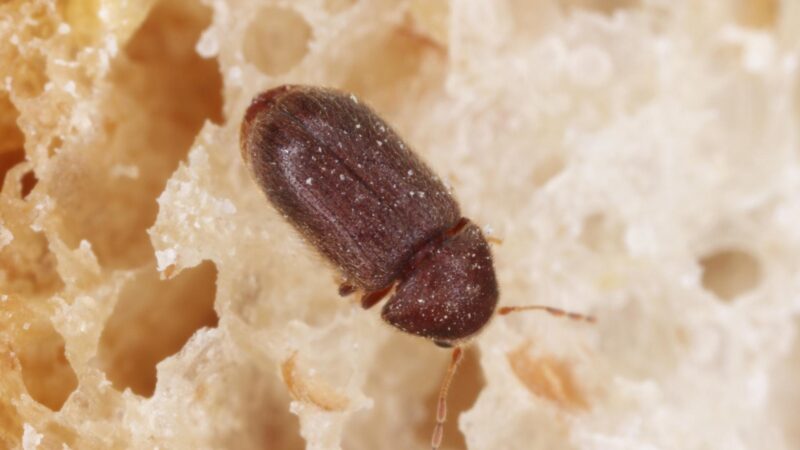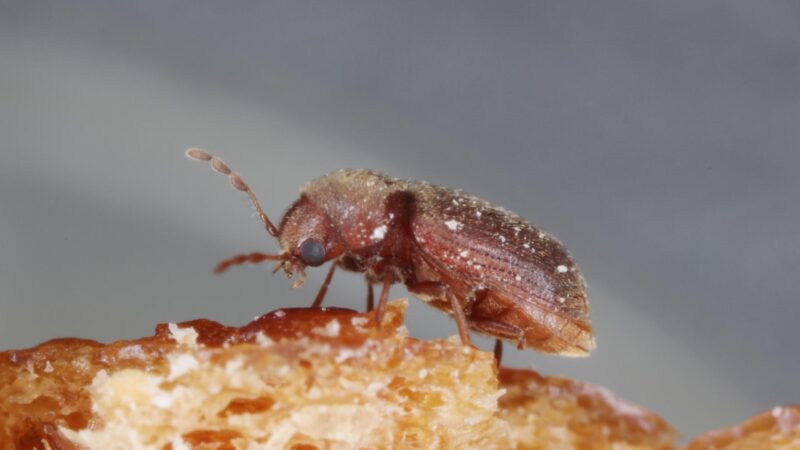Biscuit beetles are among the common pantry pests that invade houses, flour mills, bakeries, drugstores, and even museums. These fussy eaters are considered solitary and independent, but they can also be in groups with similar species. This behavior can be a huge challenge for a lot of homeowners.
So, how to get rid of biscuit beetles? All life stages of biscuit beetles are killed when exposed at 120°F for at least 16 hours. You can also place infested items at 25°F for at least 7 days. But for heavily-infested items, throwing them away will help prevent their larvae from spreading into other areas.
In this comprehensive guide, you will learn important facts about biscuit beetles, how to properly identify them, how you can control them, and what you can do to prevent future infestations.
What Do Biscuit Beetles Look Like?

Biscuit beetles (Stegobium paniceum) are 1/10 to 1/7 inch long and have a light brown to the red-brown cylindrical body. They are covered with fine silky dense hairs, while their wing covers have distinct grooves. Since their head is not seen from above, they appear to be humpbacks.
Biscuit beetles look like cigarette beetles, which are their close relatives. However, the latter have a round, oval body, and their wing covers have no distinct grooves. Biscuit beetles also have loose, 3-segmented club antennae, while cigarette beetles have serrated (sawtooth-like) antennae.
Biscuit beetle larvae have creamy white C-shaped bodies that are about 3/16 inch long. They have short hair and a dark marking on their head also ends in a straight line instead of having a convex boundary.
What Do Biscuit Beetles Feed On?
Contrary to what some people think, biscuit beetles are not only pests of biscuits and pharmaceutical drugs. They eat a very wide variety of food and non-food materials.
In fact, the only material biscuit beetles don’t eat is metal or cast iron. Larvae also don’t eat wood, but they can bore holes through it to hide and pupate.
Where Do Biscuit Beetles Come From?
Biscuit beetles are cosmopolitan pests, which means they are widely from around the world, especially in warmer regions.
There is no official record stating where biscuit beetles come from, but their damage pattern has been observed during the restoration of oil paintings, which were dated back to the 17th century.
What Is the Life Cycle of a Biscuit Beetle?

Like other beetle species, biscuit beetles undergo complete metamorphosis. They pass through four life stages: egg, larva, pupa, and adult. Females lay between 75 and 100 white eggs one by one within 6-20 days.
Eggs hatch into larvae from 26 to 100 days, depending on the weather and availability of food. Biscuit beetle larvae pass through 4 to 6 larval stages, which usually last for 4 to 20 weeks.
Their pupal stage can last for 12-18 days, which is the time when they are temporarily inactive inside a small cocoon in a food material. Once they emerge as adults, biscuit beetles will fly and can live between 16 and 20 days.
The life cycle of a biscuit beetle is completed within 2 to 7 months, which again will depend on the food source and temperature. On average, development can happen if the temperature is 60 to 93°F. But it can be at its optimal once the temperature reaches 85°F, with 60 to 90% relative humidity.
Where Do Biscuit Beetles Lay Their Eggs?
Biscuit beetles lay their eggs in almost any dry organic matter, which the larvae dig when they are about to pupate. This includes food materials such as bread, cookies, chocolates, flour, dry mixes, grains, and spices. They also deposit eggs in leather, hair, horn, wool, wooden objects, and museum specimens.
Do Biscuit Beetles Have Wings?
Adult biscuit beetles have wings, and they can fly. These female adults fly in search of a suitable food source where they can lay eggs. In most cases, they hitch a ride with food from manufacturers to the groceries, then to houses.
Are Biscuit Beetles Harmful?

No, they are completely harmless to people and pets. In fact, you can safely touch them with your bare hands. However, larvae are known for being notorious pantry pests. They cause severe damage to dry food and important belongings such as books, leather shoes, and paintings.
Do Biscuit Beetles Bite?
No, despite having biting mouthparts, this beetle species don’t suck blood and is not interested in people and animals. These so-called bread beetles are not carnivores but rather herbivores, which means that they only eat plant matter. They don’t eat meat.
Do Biscuit Beetles Carry Disease?
Biscuit beetles have not been found to be vectors of any known disease. Beetles are not dubbed parasites, which means that they don’t live in pets and humans. Therefore, adults and larvae don’t pose a health risk to humans and pets.
What Are Biscuit Beetles Attracted To?
They are attracted to almost all kinds of dry foods, sweets, plant material, and pharmaceutical drugs. They also like non-food items such as glue, hair, leather, paper, and wool. Adults are fascinated with lights at night and based on a study, they are more attracted to UV lights than blue LED lights.
Do Biscuit Beetles Go Away on Their Own?
Biscuit beetles don’t go away on their own unless they become adults. Larvae dig burrows through the substrate of their food source as they are about to pupate. They spend their entire pupal stage inside those layers and emerge once they are adults. Larvae will only leave an area if there is a food shortage.
How Do I Get Rid of Biscuit Beetles Naturally?
Despite being small and can reproduce quickly, biscuit beetles are not that difficult to control. Using insecticides can help, but it should be the last resort.
Aside from being dangerous when used indoors, they can also contaminate uninfested food. Therefore, here are some natural ways to get rid of biscuit beetles:
- For heavily-infested food products, seal them in a plastic bag and throw them away.
- For small quantities of infested items, place them in a pan and heat them at 120°F for 16-24 hours or at 190°F for at least an hour.
- Alternatively, place those infested items in a freezer at 36°F for at least 2 weeks or at 25°F for at least a week.
- Use pheromone traps such as Pro-Pest Pantry Moth Traps . They cannot kill or repel larvae but will trap the males, thus breaking their life cycle.
- Place sticky traps such as Catchmaster Insect Trap & Monitors near their food source.
Note: Instead of insecticides with harmful chemicals, use insect growth regulators (IGRs) such as Gentrol Aerosol Insect Growth Regulator .
They have low toxicity levels and are safe to use in the kitchen, hospitals, and daycare centers. IGRs don’t kill these beetles but rather prevent eggs and larvae from developing.
How to Prevent Biscuit Beetles?
Once you have eliminated all the biscuit beetles inside your house, they may still come back and infest again. Therefore, it’s also your responsibility not to allow them to return.
Knowing now about their food sources and what attracts them, here are some effective ways to prevent biscuit beetles from entering your home:
- Never purchase food packages that are not properly sealed or have a sign of damage.
- Avoid buying large amounts of grains, pet food, and other dry foods, especially during summer when biscuit beetles are most active.
- Don’t mix new stocks of dry food with the old ones. Instead, place them in sealed plastic, glass, or metal containers.
- Practice regular cleaning and vacuuming of storage areas and make sure no food debris is left in the surroundings.
- For dried specimens and dry non-food items, put some silica gel or INSECTO Food Grade Diatomaceous Earth inside the container before placing those items.
- Since biscuit beetles also eat paper, you should also do a regular inspection of your bookshelf, especially the books you seldom read.
- When not in use, keep your leather shoes, jackets, and bags inside your closet.
- Since adult biscuit beetles are great fliers, seal all potential points of entry, such as damaged window screens and tiny cracks on walls.
List of Sources
Cabrera, B. J. (2021). Drugstore beetle.
Calvin, D. (2017). Drugstore Beetle.
Harahap, I., Zungoli, P. A., & Benson, E. P. (2001). Drugstore beetles.
Merchant, M. (2018). Cigarette and Drugstore Beetle.
- Bed Bug Surge 2025: How to Detect, Prevent, and Safely Eliminate Infestations in Top U.S. Cities - June 18, 2025
- Asian Needle Ants Invade US Homes: 2025 Guide to Identification, Risks, and Effective Control - June 11, 2025
- New World Screwworm Alert: How US Livestock Owners Can Prevent Outbreaks and Protect Herds [Summer 2025 Update] - June 8, 2025
